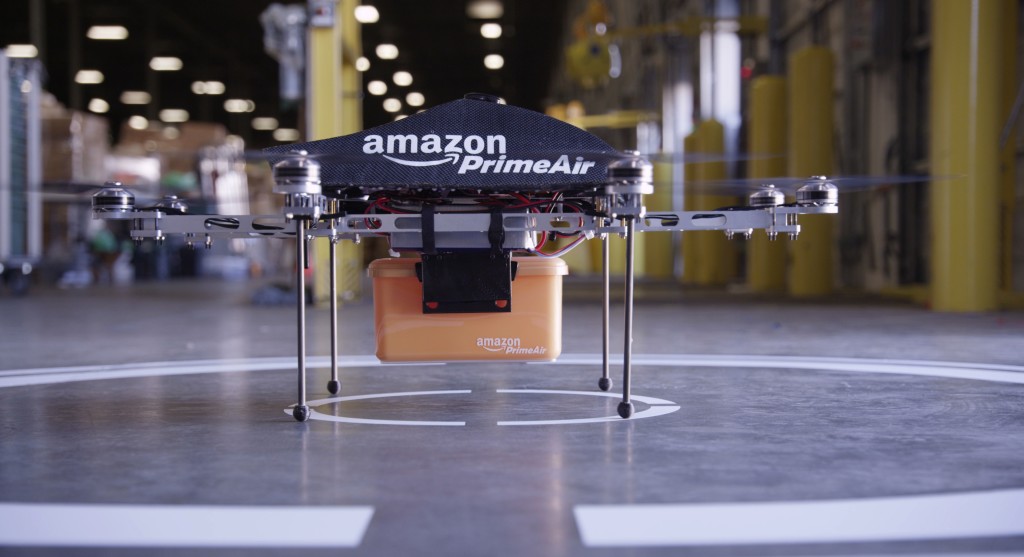Amazon announces potential delivery service drones for the mainstream consumer
The high-pitched, mechanical whine of an electric motor pervades the air. A miniature drone appears, descending over its destination. It hovers over the doorstep, deploys its package, and whirrs off into the distance. You excitedly tear open the packaging, and unearth a new iPad.
Except it’s the one you just ordered minutes ago.
When most people think of “drones”, the image that appears is one of large military aircraft carrying lethal missiles. But recently, a new use for them has surfaced: the prospect of UAVs (unmanned aerial vehicles) having civilian and commercial applications.
With “Prime Air,” online retailer Amazon.com hopes to further this transition.
In an appearance on CBS’ 60 Minutes on Dec. 1, Amazon CEO Jeffrey P. Bezos unveiled the company’s plans to deploy fleets of UAVs for delivery purposes.
According to Bezos, the drones would be completely autonomous and would be directed to the destination with GPS coordinates. The delivery time would take approximately thirty minutes with a fulfillment center located ten miles away from the destination.
Amazon Prime Air would be available for deliveries up to five pounds, which accounts for 86 percent of packages.
“Safety will be our top priority, and our vehicles will be built with multiple redundancies and designed to commercial aviation standards,” Amazon said on its Prime Air website, where the company also released a promotional video of a test drone delivering a package.
“It’d be cool to just order something from Amazon and have it delivered to your door thirty minutes later,” Nicky Semenza (12) said.
Today, commercial use of UAVs is illegal. Under the FAA Modernization and Reform Act of 2012, Congress asked the FAA to establish test sites and conduct research in an endeavor to safely legalize UAV use in domestic airspace by 2015.
Among the test site operators are the University of Alaska, the state of Nevada, Griffiss International Airport in New York, the North Dakota Department of Commerce, Texas A&M University, and Virginia Tech.
Rohith Kuditipudi (11) believes that legalizing UAVs for domestic use will be an advantage for the country.
“What a lot of people don’t understand when people talk about domestic drone use is that the drones actually have a lot of useful purposes that are non-military, that’ll actually be a tremendous benefit to our country and to our economy,” he said.
Rohith cited agriculture as one of the prime fields in which drones have potential applications.
Vincent Lin (12) also believes that UAV use in the United States would be acceptable, saying that legalizing drones would not introduce new privacy concerns.
“You can also attach a camera to a toy helicopter,” Vincent said. “Yes, [drones] are better, but toy helicopters can do the same thing and we’re not banning those, are we?”
Critics of drones maintain that legalized, unmanned aircraft have the potential to encroach on privacy in new, unprecedented ways.
“I’m not really comfortable with having drones in the consumer business, because I already feel there is enough data mining and data stealing technologies out there,” said Sanjana Kaundinya (11). “I don’t think we need another one.”
Sahana Narayanan (10) agrees, saying that drone use should be restricted to international military warfare.
“I think first and foremost as an American citizen, it’s the government’s duty to respect our privacy, and drones would violate that privilege that’s given to us,” she said. “For international purposes, when [drones are] used to better military warfare then that’s a valid excuse.”
Dr. Eric Nelson, faculty head of the Robotics program, believes that delivery by drone will eventually become a reality, as the need for instant gratification is ever increasing. Dr. Nelson pointed out that drones will also be used less in rural areas.
“It’ll be interesting to see how it’s handled in somewhat more rural areas, where shotguns are more prevalent than in downtown San Jose,” he said. “I’m sure there will be a few people that will find it fascinating to do target practice on [drones], which will probably mitigate where they’ll be used.”
Dr. Nelson also added that drone delivery services have benefits not only for the consumer, but for online retailers themselves.
“It’s expensive to maintain your own warehouse. It’ll be a big benefit to companies that don’t want to hold perishable items; so your warehouse is no longer a building, it’s a room inside an office,” he said.
Raymond Cheng (12) is a part of the Robotics program. He sees a future for drones in sports events.
“I’m thinking about what my cross country coach has mentioned,” he said. “Drones could monitor where the runners are and provide a live video feed of them, and that could potentially help multiple sports in allowing the audience to just see where they are on the field.”
Unlike track meets, watching a cross country event means the runners aren’t seen for anywhere between 15 and 20 minutes. The standard 2.93 mile course means spectators are unable to follow the progress of a race, which is mainly why cross country is not as popular as a spectator sport.
Scott Chisam, head coach of the cross country and track & field teams at the Upper School, described how drones could completely transform that experience.
“The drone goes out ahead of the first runner and sends out video to the finish line. You just sit at the finish line with a screen and you can see the leaders, for spectators and coaches to see,” he said. “We have meets now where they put a camera at the two mile [mark] so you can go online and live stream all the runners coming by the two mile mark.”
In addition to enhancing the spectators’ experience, the use of UAVs would mean injured runners could be located easily.
As drones drop in price and surge in ubiquity, the prospect of unmanned aircraft hurtling through the sky above city streets and suburban districts will ultimately seem less bizarre.
Today, Prime Air is still under development. Amazon says its army of courier drones will not be deployed anytime soon.
“I don’t want anybody to think this is just around the corner. This is years ahead at this point,” Jeff Bezos said on 60 Minutes.
In the meantime, if you’re ordering a package, the usual three-to-five business day wait will have to suffice. Or, even more shockingly, a trip to the brick-and-mortar store.
This piece was originally published in the pages of the Winged Post on Jan. 27, 2014.

Shay Lari-Hosain (12) is the Editor-in-Chief and co-founder of Wingspan Magazine. Shay has interviewed 2013 Nobel Laureates, authors like Khaled Hosseini...


















![“[Building nerf blasters] became this outlet of creativity for me that hasn't been matched by anything else. The process [of] making a build complete to your desire is such a painstakingly difficult process, but I've had to learn from [the skills needed from] soldering to proper painting. There's so many different options for everything, if you think about it, it exists. The best part is [that] if it doesn't exist, you can build it yourself," Ishaan Parate said.](https://harkeraquila.com/wp-content/uploads/2022/08/DSC_8149-900x604.jpg)




![“When I came into high school, I was ready to be a follower. But DECA was a game changer for me. It helped me overcome my fear of public speaking, and it's played such a major role in who I've become today. To be able to successfully lead a chapter of 150 students, an officer team and be one of the upperclassmen I once really admired is something I'm [really] proud of,” Anvitha Tummala ('21) said.](https://harkeraquila.com/wp-content/uploads/2021/07/Screen-Shot-2021-07-25-at-9.50.05-AM-900x594.png)







![“I think getting up in the morning and having a sense of purpose [is exciting]. I think without a certain amount of drive, life is kind of obsolete and mundane, and I think having that every single day is what makes each day unique and kind of makes life exciting,” Neymika Jain (12) said.](https://harkeraquila.com/wp-content/uploads/2017/06/Screen-Shot-2017-06-03-at-4.54.16-PM.png)








![“My slogan is ‘slow feet, don’t eat, and I’m hungry.’ You need to run fast to get where you are–you aren't going to get those championships if you aren't fast,” Angel Cervantes (12) said. “I want to do well in school on my tests and in track and win championships for my team. I live by that, [and] I can do that anywhere: in the classroom or on the field.”](https://harkeraquila.com/wp-content/uploads/2018/06/DSC5146-900x601.jpg)
![“[Volleyball has] taught me how to fall correctly, and another thing it taught is that you don’t have to be the best at something to be good at it. If you just hit the ball in a smart way, then it still scores points and you’re good at it. You could be a background player and still make a much bigger impact on the team than you would think,” Anya Gert (’20) said.](https://harkeraquila.com/wp-content/uploads/2020/06/AnnaGert_JinTuan_HoHPhotoEdited-600x900.jpeg)

![“I'm not nearly there yet, but [my confidence has] definitely been getting better since I was pretty shy and timid coming into Harker my freshman year. I know that there's a lot of people that are really confident in what they do, and I really admire them. Everyone's so driven and that has really pushed me to kind of try to find my own place in high school and be more confident,” Alyssa Huang (’20) said.](https://harkeraquila.com/wp-content/uploads/2020/06/AlyssaHuang_EmilyChen_HoHPhoto-900x749.jpeg)



